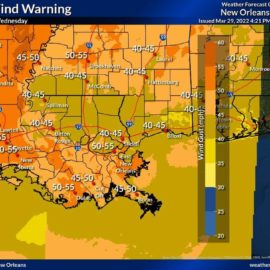
In New Orleans, our levees held. Not so much outside the city but the only one in our area to break was the levee by the Alliance refinery.
The state’s coastal authority chairman Chip Kline said it best: “No levee overtopping, no levee failures, no levee breaches — so a very different picture on the ground today after Hurricane Ida, compared to the picture we saw on the ground, following Hurricane Katrina. And that is thanks to the federal investment of $14 billion around the Greater New Orleans area.” To say the $14.5 billion invested in levee protection was a good return on investment for the American taxpayer is an understatement. The total cost of Hurricane Katrina and the federal levee failures’ damages would be nearly $200 billion in today’s dollars. This Category 4 storm will be but a blip on the radar in comparison. for years. Our people lost friends, homes and possessions. As a river parish boy myself, my heart weeps for my friends in St. James, St. John the Baptist and St. Charles parishes. I cannot imagine what we’ve lost in Lafourche and Terrebonne on top of the colossal damage in lower Jefferson and Plaquemines. But rather than curse the darkness (or even abandon living down here altogether), we should be making the point that these federal investments are proof that infrastructure dollars will reap dividends for the country in the wake of climate change. Make no mistake, the climate situation is enough for me to pull my nonexistent hair out. But rather than leave, people should be flocking here to protect our culture and our unique way of life. And there’s no need for despair — some of the greatest environmental mitigation projects the country has underway to respond to the climate crisis are happening in south Louisiana.
theadvocate.com
Ida hit us but as she moved north more people were killed in the flooding caused by the rain. We had the rain but not the flooding.
As Ida showed herself, this isn’t just a south Louisiana problem. More people died from flooding in New York and New Jersey than along our coastline where a 15-foot storm surge washed in. Despite our vulnerability, we are far ahead of the rest of the country in preparedness and resilience planning. We have a massive mitigation plan in our state’s $50 billion coastal master plan. We’ve invested tens of millions in raising homes and improving building codes. The entire New Orleans area has begun investing in projects to help us “live with water” rather than against it like the Dutch. In one Terrebonne Parish project, state government is moving an entire community to higher ground. Our wetlands are our communities’ best defense against these storms and rising seas. The combination of coastal land loss and more frequent storms is increasing our vulnerability. That’s one reason why Ida was able to remain so strong so far inland.
James Carville admits he is not a scientist and does not know or understand all the science, but in this admission he tells us that the bulk of the population does not either. He probably knows more than he admits. This is why education is so important.
I won’t pretend to know a lot about coastal science. But I do know a lot of people who do. And they tell me we have great opportunities in front of us to reconnect the mighty Mississippi River and her land-building potential directly to our starving marsh, projects like the Mid-Barataria Sediment Diversion. The Mississippi River is our greatest natural resource. It’s not rocket science. But it is the best coastal science, and it’s backed by decades of research. There is hope ahead. These types of projects have to get off the ground. With a smart strategy, we can also develop new jobs for our residents. I see an opportunity for the state of Louisiana to grow and diversify economically. Louisianans have had to endure a lot of pain to get to this point. That we are vulnerable to storms and climate change should not be a reason to hold our heads down. It’s not a time to pack up and run. Conversely, we must stay and showcase our ingenuity and entrepreneurial spirit. We can be the test case for why investing in infrastructure is so important. It’s not just a quality of life we are committing to protect — it’s a unique way of life that only exists right here.
As a professor and political activist Carville notes how we survived and notes what still needs to be done. We must be vigilant and hold politicians feet to the fire.


